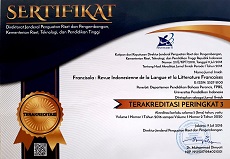La construction des rôles énonciatifs d'ordre élocutif dans le discours politique
Abstract
RÉSUMÉ. Cette étude tente d’étudier l’analyse du discours en approche interactionniste dans l’espace de la communication politique. Dans cet espace, les paroles d’un homme politique sont le reflet de sa culture et contiennent une part de subjectivité. Un homme politique utilise des énonciations subjectives ou individuelles (l’élocutif) pour reflèter son identité, son statut et sa position dans son interaction. Les objets de cette étude sont les sept discours de Nicolas Sarkozy prononcés entre 2006 et 2011 qui ont été les plus marquants pendant sa campagne et son mandat présidentiels. Pour ce travail, la première tâche à accomplir en analyse interactionniste est celle qui consiste à récueiller les données pour la constitution de son corpus lexicographique et textuel. Il faut élaborer une grille de lecture de chaque discours et identifier les marqueurs ou les traces persuasives qui se trouvent dans ces discours en utilisant le tableau lexical à l’aide de logiciel Lexico3. La fréquence d’utilisation de ces formes lexicales qui fait partie de stratégie discursive de Nicolas Sarkozy sont analysées et interprétées en utilisant la théorie Charaudeau (1992), Gumperz (1989) et Van Dijk (2007). Les résultats montrent que l’énonciations subjectives soutiennent le processus de communication interactionnelle et détiennent le pouvoir des symboles. Cette étude devrait donc contribuer au modèle d’analyse des stratégies discursive à l’approche interactionniste.
Mots-clés : discours politique, élocutif, énonciation subjective, identité.
ABSTRACT. This research attempts to analyses a discourse with the interactionist approach in the field of political communication. In this field, the utterances of a politician reflect his/her culture and contain elements of subjectivity. The politician, therefore, uses subjective or individual utterances (the elocutive) to reflect his/her identity, status, and position in his/her interaction with the audience. The objects of this study are seven speeches of Nicolas Sarkozy delivered between 2006 and 2011, and these were the most significant speeches during his presidential campaign and his presidency. The first step to conduct an interactionist analysis is collecting the data to compile a lexicographic corpus. This is to develop a reading grid for each speech and identify persuasive markers or traces that are found in each of the speeches by using the lexical table of Lexico3 software. The frequency of the use lexical forms that are parts of Nicolas Sarkozy's discursive strategy are subsequently analyzed and interpreted by using the theories proposed by Charaudeau (1992), Gumperz (1989), and Van Dijk (2007). The findings of this study show that subjective utterances support interactional communication process and hold the power of symbols. With these findings, this study can contribute to the making of the model of discursive strategy analysis with the interactionist approach.
Keywords: elocution, political discourse, identity, subjective statement.
Full Text:
PDFReferences
Bhatia, A. (2006). Critical discourse analysis of political press conferences. Discourse and Society. https://doi.org/10.1177/0957926506058057
Castra, M. (2012). identité. Les 100 mots de la sociologie, 72.
Charaudeau, P. (1992). Grammaire du sens et de l’expression. Hachette.
Charaudeau, P. (2001). Langue, discours et identité culturelle. ELA Etudes de Linguistique Appliquée, 341–348.
Delmas, V. (2012). Pour Une Analyse Pluridimensionnelle Du Discours: Le Discours Politique. La Linguistique, 48(1), 103–122.
Georis, V. (Ed.). (2005). La Communication Politique. In Formation Etopia (Centre d’animation et de recherche en écologie politique).
Gordon, C. (2015). Framing and Positioning. In The Handbook of Discourse Analysis (Deborah Ta). John Wiley.
Gumperz, J. J. (1989). Sociolinguistique Interactionnelle, une approche interprétative. L’Harmattan.
Jancsary, D., Hollerer, M. A., & Meyer, R. E. (2016). Critical analysis of visual and multimodal texts. In Methods of Critical Discourse Studies. 3rd Edition. Sage, London. Sage Publications.
Jenkins, R. (2008). Social Identity (3rd ed.). Routledge.
Kerbrat-Orrechionni, C. (2002). L’enonciation. De la subjectivité dans le langage. Armand Colin.
Kern, R., & Kern, R. (2015). Multimodal discourse. In Language, Literacy, and Technology. https://doi.org/10.1017/cbo9781139567701.010
Kissas, A. (2017). Ideology in the age of mediatized politics: From ‘belief systems’ to the re-contextualizing principle of discourse. Journal of Political Ideologies, 22(2), 197–215. https://doi.org/10.1080/13569317.2017.1306958
McGregor, S. C. (2019). Social media as public opinion: How journalists use social media to represent public opinion. Journalism, 20(8), 1070–1086. https://doi.org/10.1177/1464884919845458
Norris, S. (2011). Norris, S., 2011. Identity in (inter)Action: Introducing Multimodal Interaction Analysis. Gruyter Mouton, De Germany. De Germany.
Ofulue, C. I. (2016). Language of politics an identity: a sociolinguistic study of linguistic practices in Nigerian political campaign advertising discourse on social media. A.J. African Studies, 8(2), 229–261.
Onge, S. (2011). Interaction : Révision de Grammaire Francaise. Nelson.
Picard, D. (1992). De la communication à l’interaction : l’évolution des modèles. Communication et langages. https://doi.org/10.3406/colan.1992.2380
Tap, P. (2005). Pierre Tap Identité et exclusion. Connexions.
Van Dijk, T. (2007). Ideology and Discourse Analysis. Journal of Political, 115–140.
Van Dijk, T. (2015). Critical Discourse Analysis. In The Handbook of Discourse Analysis (Heidi E. H). John Wiley.
Van Dijk, T. A. (2006). Discourse, context and cognition. Discourse Studies, 8(159), 159–177.
Wodak, R. (2001). What CDA is about - a summary of its history, important concepts and its developments. In Methods of Critical Discourse Analysis (hal. 1–12). Sage Publications.
Wodak, R. (2012). Language, power and identity. Language Teaching, 45, 215–233.
DOI: https://doi.org/10.17509/francisola.v4i2.24208
Refbacks
- There are currently no refbacks.
Copyright (c) 2020 FRANCISOLA

This work is licensed under a Creative Commons Attribution-ShareAlike 4.0 International License.
View My Stats











